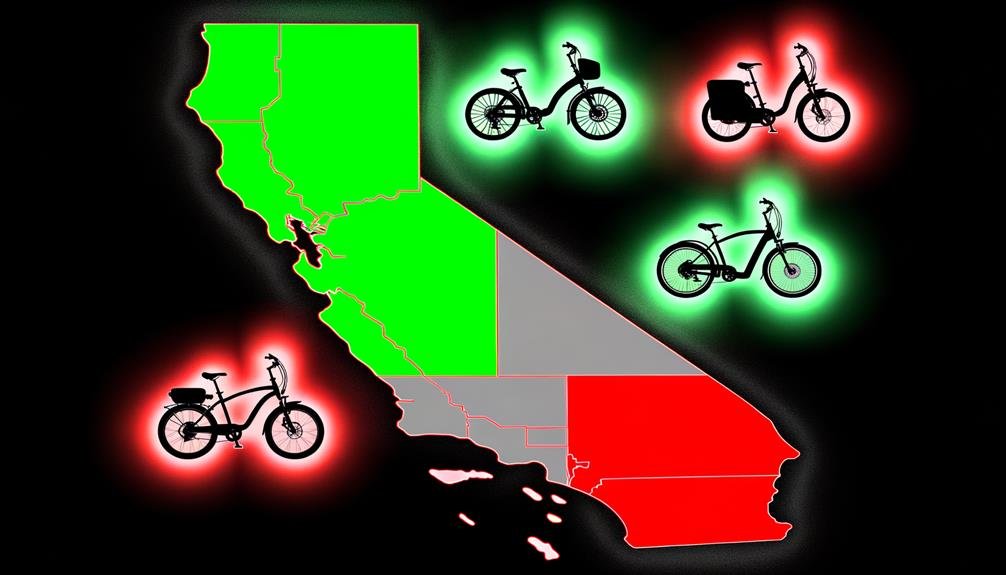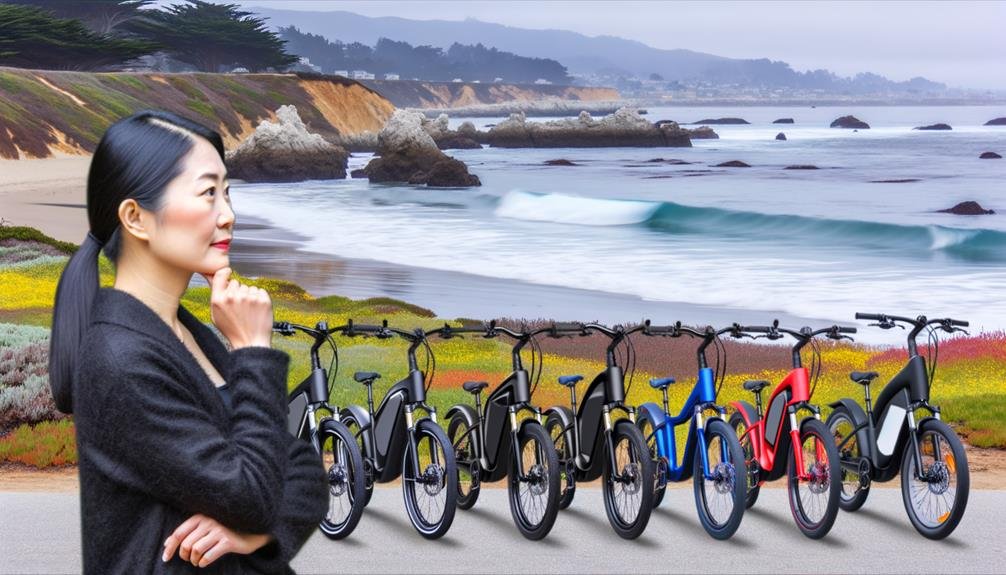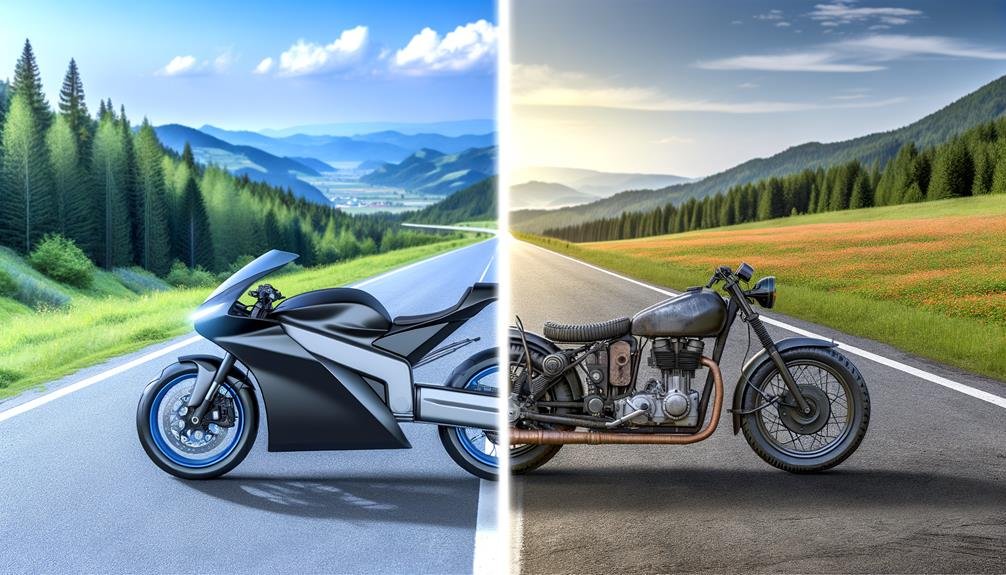Charles Miller is a veteran bike enthusiast with over 12 years of experience dealing with bikes as a mechanic. Despite immense love and expertise for...
Contrary to what you may have heard, electric bikes, or e-bikes, are indeed legal in the state of California.
As you navigate through the rapidly evolving world of e-bikes, you'll find that laws and regulations can be a bit of a labyrinth, especially when it comes to differentiating between the various types of electric bikes.
In California, e-bike laws are quite comprehensive, covering everything from operation areas and age restrictions to local ordinances and safety guidelines.
But how well do you know these laws? Stick around as we unravel the complexities surrounding the legality and use of e-bikes in the Golden State.
Key Takeaways
- California categorizes e-bikes into three classes based on motor power and assist type.
- Class 1 and Class 2 e-bikes are allowed on regular bike paths and lanes.
- Class 3 e-bikes can only be ridden on normal bike paths if permitted by local ordinances.
- Local ordinances can impose additional rules beyond state laws, so it's important to check and follow local regulations.
Understanding E-Bike Definitions
To fully grasp the concept of e-bikes in California, it's essential to understand how they're defined and categorized, particularly in terms of motor power, assist type, and the specific regulations surrounding their use.
You see, e-bikes are bicycles with electric motors that are powered by a battery. They employ a pedal assist system (PAS) when you're pedaling, and some even offer throttle assist, allowing movement without pedaling.
California state, known for its progressive stance on e-bike laws, categorizes e-bikes into classes based on their motor power and assist type. For example, Class 1 e-bikes lack throttle assist and only reach a maximum speed of 20 mph.
But the understanding of e-bike definitions doesn't stop there. When it comes to where you can ride the different classes of e-bikes, Class 1 and 2 can be ridden on regular bicycle paths and lanes, but Class 3 e-bikes' use is at the discretion of local authorities.
It's also worth noting that to operate a Class 3 e-bike in California, you need to be at least 16 years old, and a helmet is mandatory regardless of age.
Comprehensive California E-Bike Laws
Navigating California's e-bike laws, you'll find they're quite comprehensive, recognizing three distinct classes of eBikes based on motor power and assist type. These California E-Bike laws serve to integrate eBikes seamlessly into the Golden State's existing transportation ecosystem.
Class 1 and Class 2 electric bicycles are allowed on regular bike paths and lanes, mirroring the rules for traditional bikes. If you're under 18, though, you've got to wear a helmet when riding these classes – safety first!
In contrast, Class 3 electric bicycles, which are faster, can't be ridden on normal bike paths unless specifically permitted by a local ordinance.
It's important to note that while state laws provide a framework, local jurisdictions can adapt these rules to fit their specific needs. So, you'll need to keep an eye on your local regulations to ensure you're riding within the law.
E-Bike Operation Areas
Now that you've got a grasp on the different classes of e-bikes and California's state-level regulations, let's take a closer look at where you're actually allowed to operate these electric machines.
The laws governing e-bike operation in California are quite specific, especially when it comes to the different e-bike classes. Class 1 and Class 2 e-bikes can freely roam on regular bike paths and lanes in California. It's a privilege that fosters a sense of belonging among e-bike users.
However, for Class 3, the pathways are a bit more constrained. These high-speed e-bikes are permitted on normal bike paths only if allowed by local authorities.
Apart from bike paths, e-bikes can also be operated on roadways, governed by the California Vehicle Code. Yet, it's worth noting that some municipalities allow e-bike operation on sidewalks, though this varies by location. This is where local authorities come into play, as local laws may override broader California-wide rules for e-bike operation areas.
As an e-bike user in California, it's essential to be aware of these laws and respect the trails or bike paths specific to your e-bike class.
Age and Helmet Regulations
When it comes to e-bikes in California, you'll need to be aware of specific age and helmet regulations.
If you're under 16, you're restricted to Class 1 and Class 2 e-bikes, with helmets mandatory for those under 18.
For Class 3 e-bike users, you won't just need to meet a minimum age requirement of 16 – you'll also have to wear a helmet, no matter your age.
Minimum Age Requirement
In California, if you're planning to operate a Class 3 e-bike, you must be at least 16 years old, but there's no minimum age requirement for riders of Class 1 and Class 2 e-bikes.
This age regulation aims to ensure safety, as Class 3 e-bikes typically have higher speed capabilities. It's important to note that all riders under 18, regardless of the class of e-bike, must wear a helmet. For Class 3 e-bikes, helmet usage is mandatory for all ages.
You don't need a special license to ride e-bikes, making them accessible to many. Though not required for all, wearing a helmet is strongly recommended—it's an easy way to minimize risk while enjoying the freedom electric bikes offer in California.
Helmet Usage Policy
Building on the age requirements, let's examine the helmet usage policy, which is another critical aspect of e-bike regulations in California. If you're under 18 and riding a Class 1 or 2 e-bike, you need to wear a helmet. For Class 3 e-bike riders, you must wear a helmet regardless of age.
Here's a handy table to summarize:
| E-bike Class | Helmet Usage Policy |
|---|---|
| Class 1 & 2 (Under 18) | Must wear a helmet |
| Class 1 & 2 (18 and over) | Helmet recommended |
| Class 3 (All ages) | Must wear a helmet |
Keep in mind, these rules apply state-wide, but certain municipalities may have additional requirements, so always wear a safety helmet whenever possible. Join the community of responsible e-bike riders, and stay safe on the road!
Local E-Bike Ordinances

As you navigate through California's e-bike landscape, it's critical to understand that local ordinances can often impose additional rules beyond state laws. These laws can vary significantly, impacting where you can ride and what safety measures you need to follow.
Before hopping on your e-bike, you should always check your local regulations to ensure you're not only riding safely but also legally.
Understanding California's E-Bike Laws
Navigating California's e-bike laws can seem complex, but it's crucial to understand how they categorize e-bikes into classes based on motor power and assist type. The state's Department of Motor Vehicles outlines these laws, with potential local ordinances to consider.
Here's a quick breakdown:
- Class 1 and 2 e-bikes, without throttle assist and with a maximum speed of 20 mph, are allowed on regular bike paths.
- Class 3 e-bikes may need local permission for normal bike paths. Riders must be at least 16 and wear a helmet.
- All e-bikes have to follow California Vehicle Code on roadways, and local laws dictate sidewalk use.
Navigating Local E-Bike Regulations
While understanding California's state-level e-bike laws is vital, you'll also need to be aware of local ordinances that can add another layer of complexity to e-bike usage. In addition to the state's 68-page guide to e-bikes, certain local regulations may apply.
For instance, Class 1 and Class 2 e-bikes are generally allowed on all paths where regular bikes are permitted. However, Class 3 e-bikes, with their higher speeds, face restrictions on certain paths based on local laws. Helmet regulations also vary for Class 1 and Class 2 e-bikes, depending on age and locality.
Always check your local ordinances before heading out to ensure you're in compliance. By navigating these local regulations, you'll feel a sense of belonging and confidence as you take to the paths on your e-bike.
Safety Tips for E-Bike Riders
Don't overlook the importance of safety when you're cruising on your e-bike; adhering to a few crucial tips can significantly minimize the risk of accidents and injuries. As a responsible e-bike rider in California, you should always prioritize your safety and the safety of others.
Here are three safety tips for e-bike riders:
- Helmet: California laws require helmets for certain age groups and e-bike classes. Regardless of these requirements, always wear a helmet to minimize the risk of severe head and brain injuries.
- Traffic Rules: Strictly follow the rules of the road. This includes respecting speed limits, yielding to pedestrians, and obeying traffic signs. Remember, you share the bike lanes and roads with others; your actions can impact everyone's safety.
- Visibility: Be visible, especially when the rider is pedaling during low light conditions. Use bike lights, wear bright clothing, and attach reflectors to your e-bike.
These tips aren't just about adhering to the law; they're about fostering a safer e-biking community. Respect for traffic rules, bicycle paths, and other riders is as essential as the joy you get from cruising on your e-bike.
Choosing the Right E-Bike

Picking the right e-bike for your needs involves understanding the different classes, evaluating where you'll ride, and knowing the age and helmet requirements for each class.
California categorizes e-bikes into three different classes. Class 1 includes pedal-assisted electric bicycles, which only provide assistance when you're pedaling. Class 2 e-bikes have a throttle that can propel the bicycle without pedaling, while Class 3 e-bikes can reach higher speeds of up to 28 mph.
When considering the type of e-bike that best fits your needs, it's crucial to think about where you'll be riding. Different classes are permitted in different areas, such as bike lanes or pathways. Rules also dictate the age and helmet requirements for each class, ensuring your safety while riding.
Remember that modifying your e-bike can alter its classification. Any changes you make should accurately reflect on the speed classification label of your e-bike. Also, bear in mind that local laws might've additional rules for e-bike operation. It's always a good idea to consult these regulations to ensure you're riding legally and safely.
Frequently Asked Questions
Can You Ride an Electric Bike in California?
Yes, you can ride an e-bike in California. Remember to follow safety rules, interact respectfully with pedestrians, use bike lanes, register your e-bike, adhere to age restrictions, wear a helmet, and prevent theft.
What Is the E-Bike Law in California 2023?
Indeed, California's e-bike law for 2023 continues to evolve. You'll need to understand license requirements, age restrictions, helmet obligations, e-bike classifications, speed limitations, and potentially, insurance necessities. Stay informed and ride safely.
Can I Ride an E-Bike on the Road?
Yes, you can ride an e-bike on the road in California. Just remember to follow e-bike regulations and traffic laws, respect cyclist rights, and prioritize road safety. No special e-bike licensing or insurance is required.
What Is the Vehicle Code for Electric Bike in California?
You're navigating a maze of legalities. Code interpretation for e-bikes in California involves safety provisions, code amendments, regulatory challenges and potential code violations. Understanding these legal implications helps avoid enforcement issues. It's about belonging to a safe cycling community.
Conclusion
So, you're ready to mount your e-bike and conquer California's picturesque roads, right? Remember, knowledge is power. Understand your e-bike, respect the Golden State's laws, and always prioritize safety.
Helmets on, age restrictions acknowledged, and local ordinances noted. With your e-bike chosen perfectly, it's time to ride into the sunset, the electric hum of your bike harmonizing with the California dream.
Just keep it legal, keep it safe, and let the good times roll.

Charles Miller is a veteran bike enthusiast with over 12 years of experience dealing with bikes as a mechanic. Despite immense love and expertise for his Tacoma, he rides his Trek Ebike more. Anytime you meet him, you’ll either hear him talking about Bikes, or writing about all things bikes and cars on this blog.
More Posts


